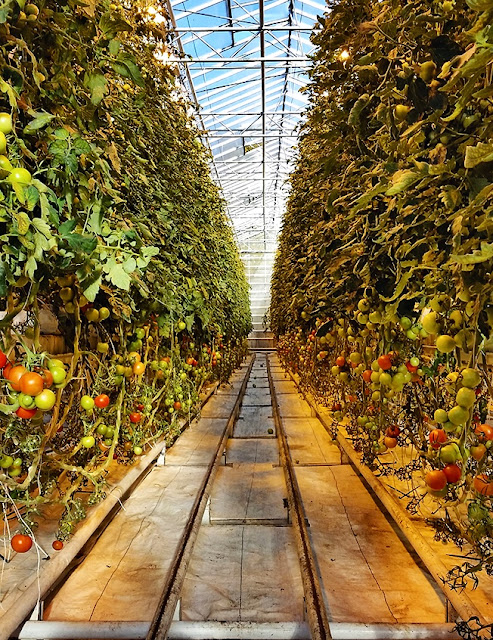July 13, 2016 Reykjavik
Our last day, and no new
herring preparations to report. I guess
we’ve seen them all.
I forgot to mention a stop
yesterday (can’t access the photos because it was before the drowning of my
camera). Friðheimar is an amazing tomato
farm, under glass, growing the most delicious tomatoes for the whole of the
country. Using geothermal heat, the enormous
greenhouses grow giant vines with a minimum of soil—almost, but not quite
hydroponic. We had a delicious tomato
soup there and toured the greenhouses, including a glimpse of the box of
bumblebees released to pollinate the new flowers at the tops of the stalks. Internet photo:
Today we toured Reykjavik
on foot, lucky to have a glorious sunny day with temperatures around 60 degrees. This is a city of 200,000 if you include the
surroundings, but feels like a somewhat bigger city because there are lots of
tourists here at this time of the year.
We began by walking past the concert hall which is on the oceanfront. It has four theaters, the largest of which
seats 1600 people. (All the photos today
are taken with my iPhone and I must say, it seems to do very well):
The Parliament is modest,
but then it has only one house with 63 members.
It dates from 1881:
The original cathedral is
adjacent to the Parliament:
Lilacs are just finishing
their bloom here in mid-July:
Nearby the parliament building
is a simple black volcanic cone, about 6 feet high, a monument to civil
disobedience. In 2009, after the banking
crisis, there were enormous demonstrations which ultimately brought down the
government. This monument was erected to
commemorate those demonstrations, and just recently, after the Panama banking
revelation, there were demonstrations again which resulted in the resignation
of the prime minister.
There are many statues in
Reykjavik, including this very fanciful monument to an unknown bureaucrat. Fully formed from the waist down, carrying a
briefcase, he is simply a rock from the waist up:
We spent an hour in the
Settlement Museum which had explanations of the Viking origins of Iceland and
artifacts from the archeological sites which have been discovered. We had wonderful tomato soup at a local
restaurant, and then, while we walked the main street of town, our guide had
arranged stops at multiple places for sampling foods: cheeses, meats (including
a wonderful marinated goose breast), waffles, chocolates, etc. It was a great and unusual lunch!
Iceland has a museum to
its first and most prominent sculptor, Einar
Jónsson, which we visited. The
sculptures are monumental, with figures which represent Icelandic themes, often
from legends. Here’s an example, which is
titled “Dawn”. It represents the end of
a legend about a troll who holds captive a woman and competes with her all
night, rhyming stanzas back and forth!
At dawn the troll turns into stone and the woman is saved:
Here’s
another which we did not get to understand:
We
then visited the main church, situated on a hill overlooking the city, the
Hallgrimskirkja. It took from 1937 to
1986 to build it, and it is striking:
The
inside is soaring as high as a medieval cathedral, but is very plain. In the back, over the entrance, is an
enormous organ, the centerpiece of the “International Organ Summer” held here
each year:
This
view from the tower shows the statue of Leif Erikson in front of the church and
the main street of the city going from the church to the waterfront:
So
we will have a farewell dinner tonight and then home tomorrow. This will be the last post (unless there’s a
story as we fly home).






















































